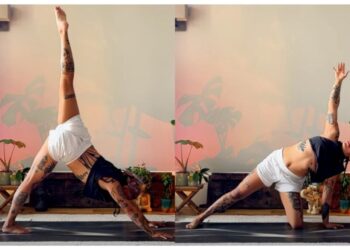The English phrase aesthetician can describe two sorts of execs. Within the much less widespread sense, it could possibly describe a thinker who makes a dwelling theorizing about artwork and sweetness. Within the extra widespread sense, it could possibly describe somebody who makes a dwelling serving to ladies with make-up and hair and nails.
These two senses have one thing to do with one another. However we don’t often discuss it.
The thought of magnificence is central to the work of each sorts of aestheticians. The phrase “magnificence” in well-liked tradition often has to do with female magnificence: magnificence salons, magnificence magazines, the sweetness business. However when Western philosophers discuss magnificence, they’re often interested by the fantastic thing about nature and of artwork (in a traditional sense); what they keep in mind often isn’t female magnificence. I believe that female magnificence was thought of beneath philosophers’ consideration for 2 causes. Prior to now, there was an informal sexist disdain for all issues female (in a approach that’s blatantly expressed in works as current as Stace’s 1960 Mysticism and Philosophy, and extra subtly in later works). As Shahidha Bari notes, that disdain has performed a big function in Western philosophy’s conventional disregard for clothes. Extra not too long ago, feminists typically contemplate magnificence requirements one thing oppressive that retains ladies down – these days not merely in educational circles however in well-liked tradition, like Jax’s music “Victoria’s Secret”. Feminist or anti-feminist, few have wished to take female magnificence critically.
But female magnificence issues – and maybe particularly in a society like ours. Another societies additionally enable males to beautify themselves, to preen and apply cosmetics and decoration. However North American societies solid a suspicion on any such exercise, viewing it, successfully, as female. Not each society is like that. However in ours, to beautify oneself is essentially the prerogative of ladies. That performs a serious function in my very own gender fluidity: I need not simply to be stunning however to make myself stunning, and in my world, that’s a female factor.
For a lot of people who find themselves raised feminine, beautification it is a burden: a further expectation positioned on prime of life’s different difficulties. However for somebody who’s been denied all of it his/her life it could possibly really feel liberating.
Frozen is justifiably one among Disney’s hottest motion pictures ever, owing above all to the magnificent video sequence for the music “Let It Go” – by which Elsa, the heroine, casts off the foundations which have stored her magical powers locked up, and comes into her personal. The sequence is a hymn to expressive individualism; many, fairly precisely, have described “Let It Go” as a coming-out music. (The film’s trite and saccharine ending is deliberately at odds with the individualist message of the music – however few actually care about that ending. “Let It Go” undermines the ending way more than the ending undermines “Let It Go”.) And crucially, the ultimate a part of the magic transforms Elsa’s hitherto utilitarian outfit into the stunningly female ice-princess gown that she is thought for. I used to be fascinated by the sequence when it got here out a decade in the past; my spouse noticed that fascination with a smile and stated “you simply wish to bang Elsa.” On the time I assumed “yeah, I can see the way you get there, however… there’s one thing else.” Just a few years later did I notice what it was: I didn’t wish to bang Elsa, I wished to be Elsa.

Elsa’s beautification understandably made some feminists uncomfortable. Dana Stevens in Slate appreciated the message of empowerment in “Let It Go”, however felt “a well-recognized sense of deflation each time that pulse-racing music (delivered so gloriously by Menzel) culminates in a imaginative and prescient of feminine self-actualization as slender and horizon-diminishing as a makeover.” But for me, few issues have expanded my horizons previously few years as a lot as a superb female makeover. The movie portrays it as horizon-expanding – very a lot so. Elsa’s garments going up the mountain are tight however drab, whereas the brand new outfit is expansive and glossy, letting herself freed from the previous wardrobe.
Stevens is reminded uncomfortably of makeover scenes in Grease and The Breakfast Membership: “These moments at all times bugged me as a child, as a result of they appeared to be last-minute reversals of the foregoing film’s message, which was that the character in query (Newton-John’s virginal Sandy, Sheedy’s glumly eccentric Allison) was fantastic simply the best way she was.” I haven’t seen these scenes, however what I recognize in regards to the “Let It Go” scene is that it’s not about “being fantastic the best way she is”, however fairly – within the phrases of a thinker whom the music’s second verse calls to thoughts – about changing into who she is. Which you can be extra really you than you have been earlier than, whenever you have been constrained by society’s chains. A degree added to by Stevens’s admission that “Elsa’s conversion right into a glammed-out ice diva does differ in necessary methods from these earlier onscreen makeovers—for one factor, her transformation isn’t meant to impress any particular suitor, and actually Elsa (not like her youthful sister, Anna) ends the film with out a romantic prospect on the horizon.”
This final level is essential. Too typically we assume that ladies beautify themselves only for the sake of touchdown a person. However this ignores how typically ladies (cis and trans) beautify ourselves for our personal sakes – or to impress different ladies. (Christian Louboutin’s designer heels have a signature visible function that simply mark them as a standing image amongst ladies – however it’s most likely one straight cis man in a thousand who is aware of what that function is.)
If the expressive in expressive individualism is about something, it’s about self-expression. And absolutely there isn’t any clearer type of self-expression than the best way that one presents one’s personal face and physique to the world. As Bari notes, “the making of, caring for, passing on and carrying of garments is steeped in our sense of selfhood, and registered in exquisitely intimate methods, by us and people round us.”
Take into account a newer makeover scene, the mall scene from Stranger Issues: the character who has spent her life an nameless captive, named solely “Eleven”, is lastly free and capable of outline herself, and a part of that self-definition is shopping for garments to develop a private model. In Milan Kundera’s existentialist novel The Insufferable Lightness of Being, the feminine lead Tereza feels equally: to be bare is to really feel an identical to everybody else, a cog within the machine, whereas by adorning herself she may specific herself as who she was. (My spouse, after having to endure a mastectomy for most cancers, determined to get a gorgeous phoenix tattoo over the scar as a result of, in her phrases, “I need one thing on my physique that I selected.”)
Referring to a state of affairs far worse than Tereza’s or mine may ever be, Gloria Wekker tells the story of a slave ship’s arrival in Paramaribo, when an eyewitness famous that enslaved ladies
had marked every others’ heads with completely different designs, suns, half moons, with out the assistance of a razor, with out even cleaning soap, solely with a chunk of glass…. The cultural vitality expressed in these photographs, amidst the horror, fixing one another’s hair… and making the insufferable bearable by means of creatively expressing themselves, is as spectacular as it’s shattering. Apparently, these shipmates, with their various locations of origin, languages, and backgrounds, had already been capable of finding a standard idiom with which to encourage themselves and one another. It’s price noting that a part of the efficiency of their subjectivity was beautification… (cited in Tinsley, Ezili’s Mirrors, p. 56)
Very similar to the fictional Eleven – herself successfully a freed slave – these actual ladies affirmed their humanity in one of the vital dehumanizing conditions potential by magnificence. And none of this was accomplished for males. The ladies on the ship beautify one another when no males are wanting; the mall scene makes no reference to Eleven’s boyfriend.
Beautifying oneself is an artwork; similar to different arts, there isn’t any single proper technique to do it, nevertheless it nonetheless takes time to learn to do it properly. As an artwork kind it’s maybe most corresponding to cooking – one other artwork typically related to ladies, and likewise too devalued in Western aesthetic idea. Like beautification, cooking too is a burden when one is anticipated to do it day-after-day, however a pleasure when one can do it for one’s personal self-expression. As with cooking, the artwork object disappears not lengthy after it’s produced, when bedtime comes and we strip off the garments and the make-up. And as with cooking it’s foolish to dismiss the artwork kind on the grounds of that transience, the best way Leon Kass does: the ending of the day’s look or the meal is just not solely just like the well-known ephemerality of a Tibetan sand mandala, but additionally like that of extra on a regular basis arts like music or drama. We acknowledge the aesthetic significance of these arts, and I feel we must always acknowledge the aesthetic significance of this one too.












